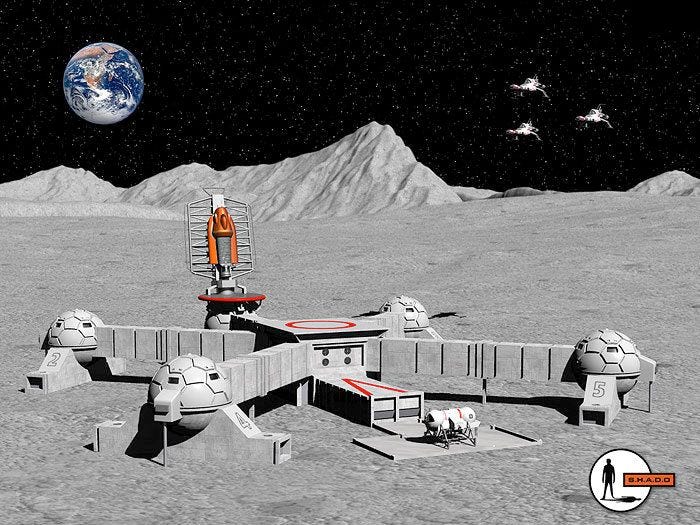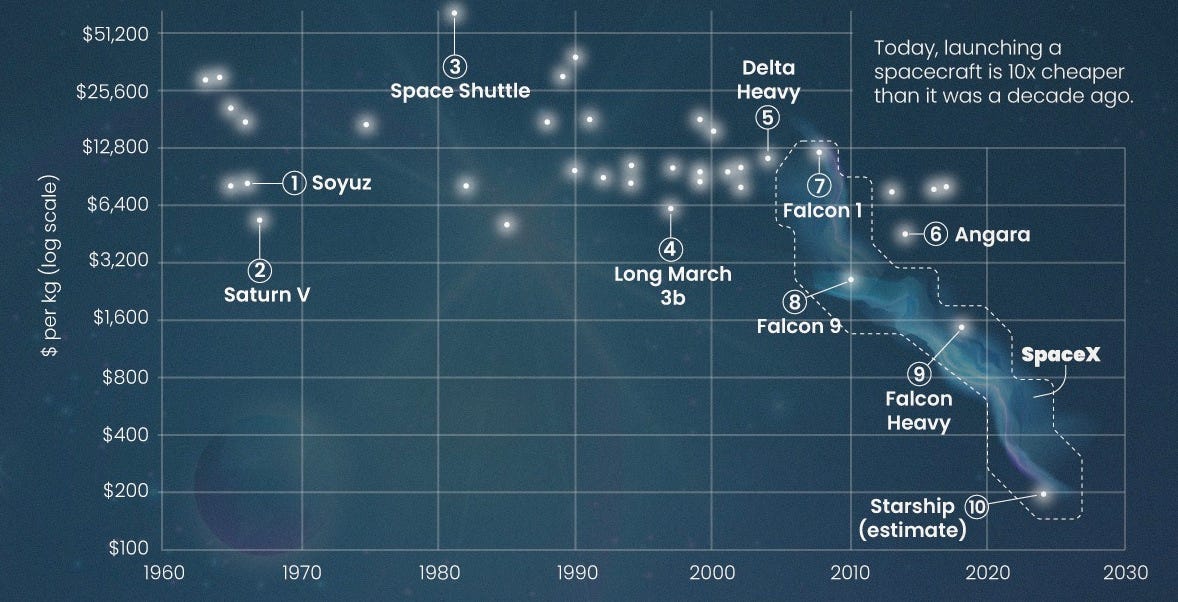Our space programs are a mess: Only re-dedication to mission - - and the drive of private enterprise - - will get us to the Moon … and Mars.
On December 5th, NASA Administrator Bill Nelson announced that the first manned flight of the Artemis Moon program would be delayed until April of 2026, the second rescheduling from the initial, planned, November 2024 date. This will also delay the following mission, a landing on the Moon, first planned for 2026 and now, 2027. The proposed Moon landing will be the first since 1972, and Mr. Nelson assures us we can get there before China's planned 2030 landing.
With Christmas right around the corner, and all of the other World news, I'm surprised I caught the announcement at all. Space, even moon landings, just doesn't grab people's attention like it did in the 1960s.
If we have already been to the Moon, over a half-century ago, why is this so difficult?
Are there lessons we can take away from this "failure to launch" pattern? What might we learn about leadership, strategy, and innovation?
OUR CURRENT MOON MISSION IS COBBLED TOGETHER FROM A BUNCH OF OTHER, CANCELLED OR FAILED PROGRAMS
NASA has a long history of this, predating Artemis. Skylab, United States' first space station, was whipped up from a variety of components that began as separate, standalone projects. The station's Orbital Workshop was, itself, fabricated from a Saturn V rocket booster's hydrogen tank. Launched over a half-century ago, on May 14, 1973, Skylab is widely considered a success: The impetus for the project, though, was NASA’s concern about losing the 400,000 workers involved in Apollo after landing on the Moon in 1969! Thus, the project began as make-work!
Two major components of the Artemis program originated in a now-cancelled Constellation program, the Orion spacecraft and the Space Launch System (SLS). Like Artemis, Constellation also had the goal of a return to the Moon as a stepping stone to a trip to Mars. Lasting only five years, between 2005-09, Constellation was cancelled when it was determined that it could not continue without additional funding.
"A kludge or kluge is a workaround or makeshift solution that is clumsy, inelegant, inefficient, difficult to extend, and hard to maintain." - Wikipedia
Digging into these programs, I find what I will call a repeated "cancel - rename - reuse loop": This leaves me a bit sad and conflicted.
By way of analogy, I want you to think of a restaurant. NASA is, in my view, an earnest and skilled, short-order cook, always tasked with cooking and serving up inexpensive meals, quickly. It is quite impressive what they manage to do - - read the Skylab history, if you want proof of this - - BUT, it is sad, as well.
Over and over, we tell cook NASA that we want a visionary, multi-course meal - - like a colony on the Moon … or Mars - - and then we underfund the meal and change the menu, on a whim. So the original wagyu beef gets ground into ground steak for "hamburgers", and then, on another whim, ends up served as a filling, with rice and black beans, in a "breakfast burrito". NASA is ever rummaging around in the cupboards and the frig to "whip up a meal" for fickle, demanding, and ever-changing customers.
This brings me to points one and two:
ONE: To get to Mars, or a Moon colony as a stepping stone, WE, the American people, the Congress, and the President will need to be "sold". Why it is important?
I don't know about you, but I have a bit more than a passing interest in this stuff and I am still not totally sold. In my opinion, the intellectual leap you must make is to understand the need to establish a colony on Mars. After you do so, then you can understand why we put astronauts in space suits AT ALL these days AND why we need to learn more about living in space … this gets you to a Moon colony.
The Moon base in the illustration, above, is from "UFO", a 1970 British science fiction television series. You can watch all the episodes for free on the big streaming site. It's fun: They man the outpost to protect Earth from hostile, visiting extra-terrestrials.
I wrote a post, "ZOMBIES, VAMPIRES, ALIENS! Plan for Those, Plan for All" which will give you a look into Elon's mind, so you can understand his obsession with going to Mars and why we should.
TWO: Programs need to be adequately funded. This follows from point ONE, if the mission is important, it gets adequately funded.
Few know this, as we are naturally fond of remembering how glorious it was to actually have landed on the Moon, but many opposed the program which led to it.
Neil Maher, author of "Apollo in the Age of Aquarius", describes the division between two groups: Those who believed landing on the Moon would energize a broken and lost country and those who believed it was a huge waste of money that could be better used to solved more pressing societal problems. Sound familiar?
NASA, IN AN ATTEMPT TO SELL ITS MISSIONS AND GET BUY-IN, CREATES A LOT OF COMPLEXITY AND INEFFICIENCY
The United States House of Representatives has 435 members, apportioned to the States by population. California, Texas, and Florida, added together, have about 120 members. That's a lot of votes, when it comes to securing the votes necessary for funding. Not totally by coincidence, those three states host the major NASA facilities and companies in those states are NASA's biggest suppliers and partners.
Where NASA locates facilities, where it spends money, where it creates jobs, and a host of other decisions are driven by - - or at least significantly influenced by - - the desire to garner support for its mission and budget from the elected members of Congress.
The desire for buy-in extends overseas as well. NASA lists as its agency partners ESA (Europe), JAXA (Japan), DLR (Germany), ASI (Italy), ISA (Israel), MBRSC (Dubai) and CSA (Canada). Thus, the Artemis program must navigate the various needs and wishes of these, and many other, government partners as well. Can you imagine the difficulty of even coordinating meetings, let alone agreeing on mission objectives?!
NASA is also trying to navigate a course between shifting political and social interest groups. That image, above, is from the Artemis homepage - - the first thing one sees. Below that, if you scroll down, is "Why We Are Going to the Moon"[!] So what is the mission of Artemis, NASA?
While any and all of these efforts to achieve buy-in have value in their own right, they are all subordinate to the mission, Moon then Mars. It's nice to have a Canadian on the crew, IF we make it to Mars!
THREE: Mission objectives need to be clearly articulated and emphasized over all other "nice-to-haves".
PRIVATE COMPANIES, THE "NEW SPACE", CAN BREAK THE LOGJAM AND TAKE US TO MARS
Let me tell you a tale of woe: The tale of the Space Launch System (SLS) mentioned above, you know, the rocket that was going to be used in Artemis that got reused from the underfunded and cancelled Constellation program. The SLS uses recycled engines from the Space Shuttle - - I am not kidding you. A company named Aerojet got paid $2 billion to spruce up 16 engines that NASA already OWNED and then only delivered FIVE. Thus, NASA paid $400 million per engine!
"SpaceX currently builds the far more advanced Raptor engine for under $1m each, and launches the entire Falcon 9 rocket for less than $20m." - Casey Handmer
This is insane.
Again, I have some sympathy for our short-order cook, NASA, but the entire government purchasing and contracting system is broken. Elon? Vivek?
FOUR: If your organization is overly complex and swamped by competing objectives, outsource key aspects to focused partners.
You see, in the graphic from Visual Capitalist, that SpaceX is radically reducing the cost of launching payload. [note log scale on left!]
Revisit the Handmer quote above: There is ZERO argument in favor of using legacy launch systems in the era of "New Space", with companies like RKLB, SpaceX, Stoke, and Blue Origin.
NEW SPACE, UNTETHERED TO COMPLEX STAKEHOLDER BUY-IN BATTLES, CAN LEVERAGE PROFIT MOTIVE TO GO TO MARS
Some are fond of saying, unless the USA gets its act together, Elon - - or someone else - - will get to Mars and - - if the US is lucky, they'll get to slap a sticker on it!
On April 6, 2020, in his previous administration, Trump signed "Executive Order on Encouraging International Support for the Recovery and Use of Space Resources".
"Americans should have the right to engage in commercial exploration, recovery, and use of resources in outer space, consistent with applicable law. Outer space is a legally and physically unique domain of human activity, and the United States does not view it as a global commons. Accordingly, it shall be the policy of the United States to encourage international support for the public and private recovery and use of resources in outer space, consistent with applicable law." - EO, 4/6/2020
Instruments on NASA’s Lunar Reconnaissance Orbiter (LRO) suggest the lunar subsurface contains higher concentration of certain metals, such as iron and titanium, than previously estimated. NASA estimates that 600 million to one billion metric tons of lunar ice could be harvest to create fuel.
Private companies are rightly focused on two things, lowering the cost of lifting payload into space and mining space-based resources.
FIVE: Create strong complements: Other parties, whose mission is aligned with yours, can help you achive your goals.
Good public policy would be for the United States to encourage all private, space-related activities. By creating a political, legal, and economic environment where they can thrive, NASA can hitch a ride, a ride to the Moon, and then Mars!











